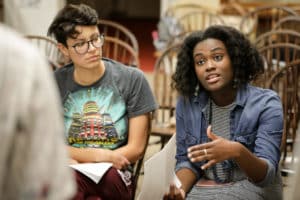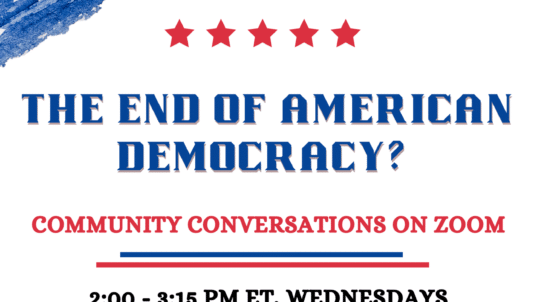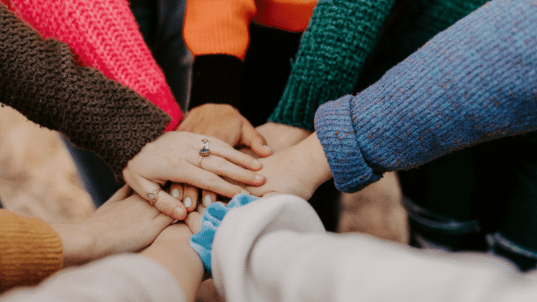
(c) Mary Ann Bates, all rights reserved, [email protected]
Students at Wesleyan College in Macon, Georgia, co-created a second year of successful Diversity and Inclusion Discussions (DID) based on skills they learned from the Interactivity Foundation’s IF Discussion Facilitation Process. This renewed series of discussions built upon students’ interest to take student-facilitated outside of the classroom and into the broader campus community. Tonya Parker, Assistant Dean of Students for Diversity and Inclusion, and I teamed up again to welcome a new group of six enthusiastic and talented student facilitators: NyAnna Miller, Ashley Darby, Jaylyn Dickerson, Dy-Onna Stith, Attallah Battle, and Ziyue Fang.
Developing and Convening Peer to Peer Discussions
At their first training session in September, we shared the basics of the IF Process and prepared them to lead a series of two-hour student-driven conversations over the course of the fall semester. Tonya and I helped the facilitators learn tactics such as posing questions in an open-ended way, maintaining a sense of sanctuary and supportiveness with positive “yes…and” conversation strategies, and modeling active listening practices to their discussion groups. We also helped the facilitators create recruitment strategies to ensure that a broad cross-section of students felt welcomed to join the discussions.
Our facilitators were excited to begin in October, and we had a strong student turn-out of 20-25 undergraduates for each of our three main discussion sessions. Thanks to support from the Interactivity Foundation, we were able to offer students a meal at each meeting and a t-shirt for those who participated in at least two of the three main discussions. This extra touch helped motivate students to commit to the long-term discussion-building process, and everyone arrived at the sessions ready to imagine new possibilities for Wesleyan.
The Post-Election Atmosphere and Confronting the Past
This was a particularly charged year for our college community. The wave of hate speech that surged in the wake of the 2016 election hit Wesleyan as well. Last January, racial slurs against blacks and immigrants were found written on the walls and doors in a student residential building. This hate crime continued to reverberate into the fall semester. Many students participated in the DID program expressly to work on ways to create a stronger sense of community across campus. Wesleyan has also begun to address its history as a slave-holding institution. There has been much debate over some of Wesleyan’s lingering sisterhood traditions and racially insensitive iconography. The fall term began with a campuswide convocation sharing content from the school’s archives that documents a troubling history of racism, one which parallels that of many Southern institutions founded during the antebellum era. An intense debate has emerged about how to properly recognize the school’s past and to continue to work on our current blind spots as we rethink the needs of Wesleyan students today. This complicated and multi-layered topic flowed along with other student concerns into the three main discussion sessions this fall.
Outcomes and Impacts from the Discussions
Like last year’s pilot program, the DID sessions again provided a supportive space for students to identify and process the complex diversity and inclusion needs on campus. This year, highlights of the discussions included:
- Reimagining the identity of the college in ways that are more consciously inclusive
- Creating more active diversity programs in the residence halls through RA and Student Life activities
- Establishing more support systems for students with disabilities, both in terms of accessibility on campus grounds, and in terms of medical and mental health services
- Finding new approaches to offer consistent diversity and inclusion training for all members of the campus community
- More diverse hiring practices among faculty, staff, and administration
The discussion groups focused heavily on potential ways to enhance inclusion practices through campus social activities. The facilitators collected a number of creative suggestions from their working groups and presented them to faculty, staff, and administrators in late November. Their ideas were positively received and are currently being considered by the college’s Strategic Planning committee.
My colleague Tonya Parker and I are naturally very proud of the energy, enthusiasm, and commitment of both the facilitators and the group participants. But perhaps student feedback does more to show that the second DID program this fall was a success:
“I am so appreciative of this program…for providing an outlet as well as a foundation and information for how to solve problems, including initiating solutions to them. This has brought hope to my heart for the future class to come and what they have to offer.”
“I really liked this. I’m really a quiet person, but my group was so respectful and thoughtful and encouraged me to participate. Great discussion!”
“I am always recommending this to everyone I know. I think it’s an awesome place to gauge other students’ opinions on topics not only that I care about but topics that mean something to others around me.”
“It was eye-opening.”
“I would love to be a facilitator next year!”
And our facilitators noted:
“I hope to provide a warm and productive atmosphere, so that those pessimistic and sardonic voices we hear in our subconscious at times can be muted in order to make change within our own communities.”
“I feel that the training we are receiving is setting up us to be or become stronger organic leaders, which I admire. Learning how to talk to people, diffuse situations, and still come up with ideas from opposing sides is an invaluable life lesson.”
“I think it was good that we began working with our partners at the first meeting. We were able to discuss our viewpoints with one another, read through scenarios together so when it was time to facilitate, we had a familiarity with one another. Having that rapport with our partners probably helped the students feel comfortable talking because the established environment was warm and welcoming. The training sessions really encouraged us to listen and encourage the students to talk more than we did. I liked that we did a test trial session during training. It helped us learn when to say certain phrases and really feed off what the students are saying to guide the conversation.”
“To me, the most useful tactics are those detailed communication strategies, such as how to deal with negative feelings, how to begin a transition in discussions.”
As this year’s student participants suggest, the IF discussion process has become integral to building civil discourse at Wesleyan, both inside and outside the classroom. We continue to discover new ways to implement it. For example, we plan to use the IF process in racial healing discussion groups at different levels of the institution, from students to faculty to alumnae, as we continue to process our past and rethink our future. Finally, we hope to feature the work of our student facilitators at a regional conference on best practices in collaborative teaching and learning this spring. Wesleyan is thankful for the generosity and support of the Interactivity Foundation, and we look forward to the continued success of the DID program.



